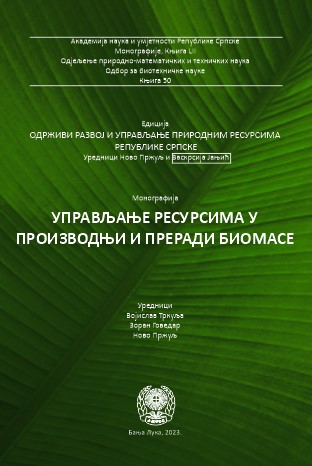Biomass as a renewable energy source
DOI:
https://doi.org/10.7251/EORU2306001TKeywords:
Biomass, classification, history of use, current situation, processing methods, challenges of useAbstract
Conventional energy sources such as fossil fuels, oil, coal and natural gas methane are non-renewable energy sources that were once considered primary energy sources and are depleted due to intensive use which has led to the escalation of the global energy crisis. In addition, the use of fossil fuels has a significant disadvantage in terms of the emission of toxic and harmful gases into the atmosphere that pollute the environment. An alternative to the use of fossil fuels is to obtain energy by processing biomass obtained in the process of photosynthesis and used as a raw material for bioenergy production. Biomass refers to non-fossilized biological material obtained from living or until recently living organisms and biodegradable organic or carbon-based material originating from plants, animals, plant materials and microorganisms. Bioenergy can be defined as a source of energy obtained from organic matter or biomass that is explicitly used for energy purposes. Bioenergy is the largest renewable energy source in the world, which still has a large share in the supply of renewable energy sources and accounts for 70% of the total supply of renewable energy sources. Today, bioenergy is the only form of energy that meets the criteria of a closed system, in terms of the creation of carbon dioxide and solid material products of combustion. Most of the carbon released in the form of carbon dioxide is absorbed by the next generation of plants through photosynthesis or through minerals from the soil. Therefore, biomass is becoming one of the key energy resources in the fight against global warming and depletion of fossil fuel reserves. It should be noted that the primary advantage of biomass as an energy source is not in its significant potential, but in renewability. Renewability is the essential advantage that biomass has over conventional, fossil fuels that are nonrenewable and therefore cannot be the basis for long-term planning of sustainable growth that implies rational use of energy. Biomass is not a source of energy in transition, as it is often presented, but a resource that is becoming increasingly important as a modern energy source. Therefore, this chapter provides a detailed overview of biomass as the world’s largest source of renewable energy, including definitions of biomass, a history of biomass use, and current bioenergy production from biomass. Data on theclassification/categorization of biomass and the main methods for the production of bioenergy from biomass, as well as the advantages and disadvantages of using biomass for bioenergy production, are presented. Emphasis is placed on the impact of biomass on the environment and biodiversity, as well as the most significant current challenges in the use of biomass for bioenergy production, including moisture content and density of biomass, its complexity and diversity, selection of optimal pre-treatment methods and biomass processing conditions and lack of biomass data, as well as challenges to the economic sustainability of bioenergy production from biomass and other environmental, economic and social challenges.
